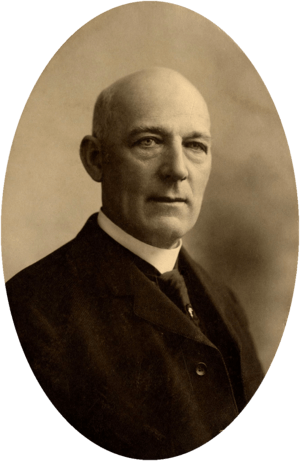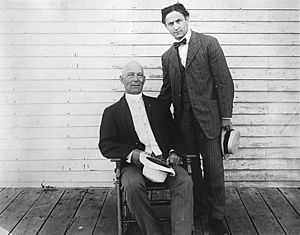Harry Kellar facts for kids
Quick facts for kids
Harry Kellar
|
|
|---|---|
 |
|
| Born |
Heinrich Keller
July 11, 1849 Erie, Pennsylvania
|
| Died | March 10, 1922 (aged 72) Los Angeles, California
|
| Resting place | Angelus-Rosedale Cemetery |
| Occupation | Illusionist |
| Signature | |
Harry Kellar (born July 11, 1849 – died March 10, 1922) was a famous American magician. He put on big stage shows in the late 1800s and early 1900s.
Kellar was a very important magician. He came before Harry Houdini and learned from other magicians like Robert Heller and Isaiah Hughes. People often called him the "Dean of American Magicians." He performed his amazing tricks all over the world, on five different continents!
One of his most famous tricks was making a girl float in the air. He called it the "Levitation of Princess Karnac." This trick was inspired by an illusion created by John Nevil Maskelyne. Later, another famous magician, Harry Blackstone, Sr., bought Kellar's version of the trick. Kellar also bought many of his special magic props and sets, like the "Blue Room," from the Martinka Magic Company.
Contents
Early Life and Magic Beginnings
Harry Kellar's real name was Heinrich Keller. He was born in Erie, Pennsylvania. His parents were immigrants from Germany. He later changed his name to Harry Kellar to avoid being confused with another magician, Robert Heller.
As a child, Harry loved adventure. He even played dangerous games, like "chicken" with trains! He also worked for a druggist (someone who prepares medicines). Harry liked to mix chemicals, and one time he accidentally blew a hole in the floor of the drugstore!
To avoid trouble with his parents, young Harry ran away. He was only ten years old. He rode trains without a ticket and became a traveler.
A kind minister from New York befriended Harry. He offered to adopt Harry and pay for his schooling if Harry would study to become a minister too. But one night, Harry saw a traveling magician perform. The magician was Isaiah Harris Hughes, also known as "The Fakir of Ava." Harry was amazed! He later told Houdini that he "immediately got the urge to go on the stage." He bought magic books and left his kind friend to follow his dream.
When Harry was 12, he saw an ad for an assistant placed by Isaiah Hughes. Harry got the job! At 16, he tried his first solo show in Dunkirk, Michigan. It didn't go well, so he went back to working with Hughes. Two years later, he tried again, and this time he did much better. However, he was often short on money. He sometimes had to borrow equipment for his shows and avoid people he owed money to.
Kellar's Amazing Career
In 1869, Kellar started working with a group called "The Davenport Brothers and Fay." They were known for their stage spiritualism shows. Working with them, Kellar learned a lot about how to put on a successful magic show.
Kellar worked with them for several years. In 1873, he and William Fay left the Davenports. They started their own "world tour" through Central and South America. In Mexico, they earned a lot of money, about $10,000! Their tour ended in Rio de Janeiro in 1875, where they even performed for Emperor Dom Pedro II.
On their way to England, Kellar and Fay's ship, the Boyne, sank in the Bay of Biscay. Kellar lost all his magic equipment, clothes, and even the ship's valuable cargo of gold, silver, and diamonds. He was left with only the clothes he was wearing and a diamond ring. To make things worse, his bank in New York failed.
Desperate for money, Kellar sold his ring. He and Fay went their separate ways. Kellar could perform in Dutch, French, and English, which helped him continue his tours around the world.
After visiting the Egyptian Hall theater in England, Kellar was inspired. He loved the idea of performing in one place for a long time. He admired the illusions performed by Maskelyne and Cooke. He was especially impressed by Buatier de Kolta's "The Vanishing Birdcage" trick. Kellar spent almost all his remaining money to buy this trick!
Kellar borrowed $500 from Junius Spencer Morgan (a famous banker's father). He returned to the United States to get money from a bank transfer he had started in Brazil. He managed to get back $3,500. With this money, Kellar started his own magic company, similar to Maskelyne's. He even named his theater the Egyptian Hall.
In 1878, Kellar went back to England. He spent $12,000 on new equipment. This included a version of Maskelyne's "Psycho," a machine that seemed to play cards by itself.
After a difficult tour in South America, Kellar returned to New York. He heard that another magician, Robert Heller, had died. A newspaper, The New York Sun, accused Kellar of trying to copy Heller's fame by using a similar name. Kellar tried to explain that his name had always been Keller (with an "e") and that he had changed it years ago to avoid confusion with Heller. He also pointed out that Heller had changed his own name. But the public was still not happy. Kellar canceled his shows in the U.S. and went back to Brazil.
In 1882, during another world tour, Kellar met Eva Lydia Medley in Melbourne. She was a fan who came backstage for his autograph. They wrote letters to each other for five years.
Kellar opened his first Egyptian Hall in December 1884. It was in an old Masonic temple in Philadelphia, Pennsylvania. He performed 264 shows there before closing it in June 1885. Soon after Kellar left, the theater burned down.
While Kellar was performing in America, Eva Medley arrived. She joined his show, playing the cornet and learning about magic. Kellar and Medley got married on November 1, 1887, in Kalamazoo, Michigan. Eva became a very important part of Kellar's shows. She helped with illusions and provided music.
Kellar opened his second Egyptian Hall in Philadelphia in October 1891. It was also on Chestnut Street. This theater was very successful, running for seven months until April 1892. After that, Kellar went back to touring.
During the times Kellar was traveling abroad, another magician named Alexander Herrmann became very famous in the United States. When Kellar returned, he found he had a rival. Herrmann often said that Kellar wasn't good at sleight of hand (quick hand movements). He claimed Kellar used more mechanical tricks. Kellar admitted he wasn't a master of sleight of hand. But he was amazing at misdirection. He once said that even a "brass band playing at full blast can march openly across the stage behind me, followed by a herd of elephants, yet no one will realize that they went by." Herrmann passed away on December 17, 1896.
Later Life and Retirement

Harry Kellar retired from magic in 1908. He chose Howard Thurston to be his successor. Kellar had met Thurston, who was doing amazing card tricks, while on vacation in Paris. Kellar's very last show was at Ford's Theatre in Baltimore, Maryland.
After retiring, Kellar moved to his house in Los Angeles, California. His wife, Eva, passed away two years later.
Other magicians often visited Kellar, especially Harry Houdini. On November 11, 1917, Houdini organized a special show for the Society of American Magicians. The show was to help the families of those who died when the USS Antilles ship was sunk by a German submarine during World War I. Houdini convinced Kellar to come out of retirement for one last performance.
The show took place at the New York Hippodrome, which had the largest stage at the time. After Kellar's performance, he started to leave. But Houdini stopped him. Houdini said that "America's greatest magician should be carried off in triumph after his final public performance." Members of the Society of American Magicians helped Kellar into a special chair. They lifted him up, and the Hippodrome orchestra played "Auld Lang Syne" as Kellar was slowly carried away. It was a grand farewell!
Kellar lived in retirement until he passed away on March 3, 1922. He was buried in Angelus-Rosedale Cemetery in Los Angeles.
Kellar's Famous Illusions
The Levitation of Princess Karnac
This was one of Kellar's most famous tricks. He would claim the woman on stage, who appeared to be sleeping on a couch, was a Hindu princess. He would then make her float in the air! To prove she wasn't being held up, he would pass a large hoop all around her body.
The secret was a clever machine hidden from the audience. Inside the "princess"'s dress was a flat board she rested on. This board was connected to a metal bar that went off the side of the stage, hidden by curtains. The other end of the bar was connected to a machine that could raise and lower the woman. The bar was shaped like a rough "S." This special shape allowed Kellar to move the hoop completely around her body, making it look like she was truly floating.
The Nested Boxes Trick
For this trick, Kellar would borrow six finger rings from people in the audience. He would load them into a toy pistol, aim it, and "fire" at a chest hanging on the side of the stage.
The chest would be opened, and inside it was another, smaller chest. Inside that one were six boxes, one inside the other, like Russian nesting dolls. As each box was opened, they were stacked up. Inside the very smallest box were five of the rings, each tied with a ribbon to a flower. These five rings were returned to their owners.
The owner of the sixth ring would wonder what happened to theirs. Kellar would pretend not to notice and move on to his next trick. This next trick was a version of Robert-Houdin's "Inexhaustible Bottle." Audience members would call out different drinks like wine, whiskey, or lemonade. Kellar would pour each drink from the same bottle, and everyone would agree they got what they asked for.
Once the bottle was empty, Kellar would break it open. Inside was a guinea pig with a sash around its neck. Attached to the sash was the sixth ring! The ring was then given back to its owner.
Kellar even performed a version of this trick for President Theodore Roosevelt and his children. Ethel Roosevelt was the owner of the sixth ring. After Kellar returned her ring, he asked if she wanted the guinea pig as a pet. He wrapped the guinea pig in paper and handed it to Ethel. But when she opened it, inside was a beautiful bouquet of pink roses instead!
The Vanishing Lamp
In this illusion, a glowing lamp sat on a glass table. Kellar would cover the lamp with a thin cloth. He would tell the audience that every evening, the lamp would magically return to its original owner in India at a specific time.
As a bell chimed the current time, Kellar would load a pistol and aim it at the lamp. At the very last chime, Kellar would fire the pistol. The lamp would seem to melt away, and the cloth would simply fall to the stage, showing that the lamp was gone!
Kellar was known to have a quick temper. Once, when the "Vanishing Lamp" didn't vanish, he famously took an axe to the broken prop! Later, he built another one that worked perfectly for many years, even after he retired.
See also
 In Spanish: Harry Kellar para niños
In Spanish: Harry Kellar para niños
- List of people from Erie, Pennsylvania
- List of vaudeville performers


